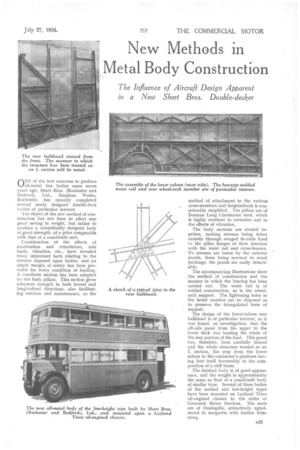New Methods in Metal Body Construction
Page 43

If you've noticed an error in this article please click here to report it so we can fix it.
r-INE of the first concerns to produce all-metal bus bodies some seven years ago, Short Bros. (Rochester and Bedford), Ltd., Seaplane Works, Rochester, has recently completed several newly designed double-deck bodies of particular interest.
Thc object of the new method of construction has not been to effect any great saving in weight, but rather to produce a scientifically designed body of great strength, at a price comparable with that of a coachbuilt unit.
Consideration of the effects of acceleration and retardation, side loads, vibration, etc.. have revealed many important facts relating to the stresses imposed upon bodies, and an ample margin of safety has been provided for every condition of loading. A cruciform section has been adopted for the body pillars. This section gives adequate strength in both lateral and longitudinal directions, also facilitating erection and maintenance, as the method of attachment to the various cross-members and longitudinals is considerably simplified. The pillars are of Dorman Long Chromador steel, which is highly resistant to corrosion and to the effects of vibration.
The body sections are riveted together, racking stresses being taken entirely through swaged fie-rods fixed to the pillar flanges at their junction with the waist rail and cross-bearers. No stresses are borne by the exterior panels, these being screwed to wood packings; the panels are easily detachable.
The accompanying illustrations show the method of construction and the manner in which the bracing has been carried out. The waist rail is of welded construction, as is the wheelarch support. The lightening holes in the latter member are so disposed as to preserve the triangulated form of support.
The design of the lower-saloon rear bulkhead is of particular interest, as it was found, on investigation, that the off-side panel from the upper to the lower deck was bearing the whole of the rear portion of the load. This panel has, therefore, been carefully braced and the whole structure treated as an L section, the step from the lower saloon to the conductor's platform having lent itself favourably to the cornrn position of a stiff beam.
The finished body is of good appearance, and the weight is approximately the same as that of a coaehbuilt body of similar type. Several of these bodies of the normal and low-height types have been mounted on Leyland Titan oil-engined chassis to the order of Greenock Motor Services. The seats are of Dunlopillo, attractively upholstered in moquette with leather trimming.




































































































